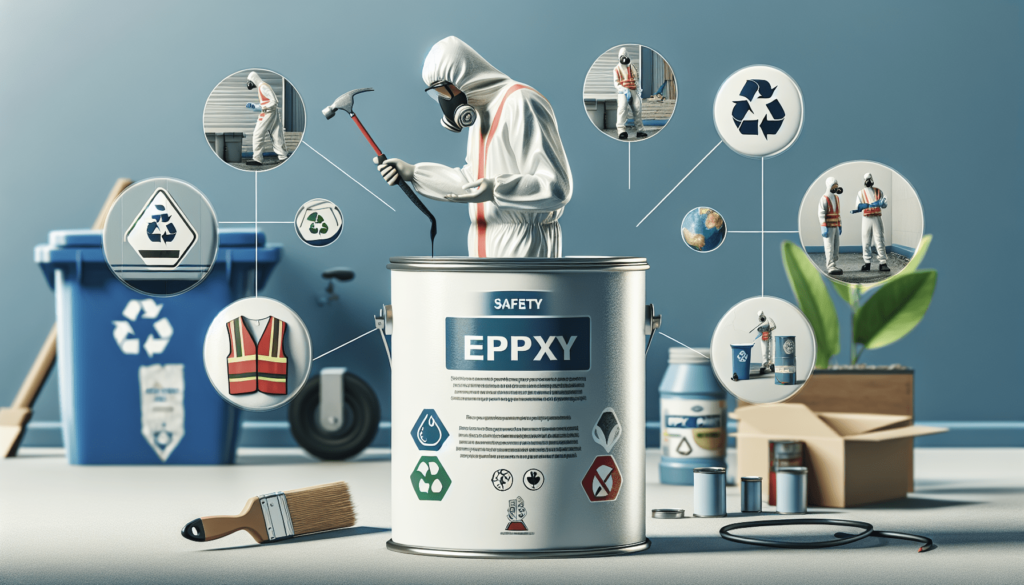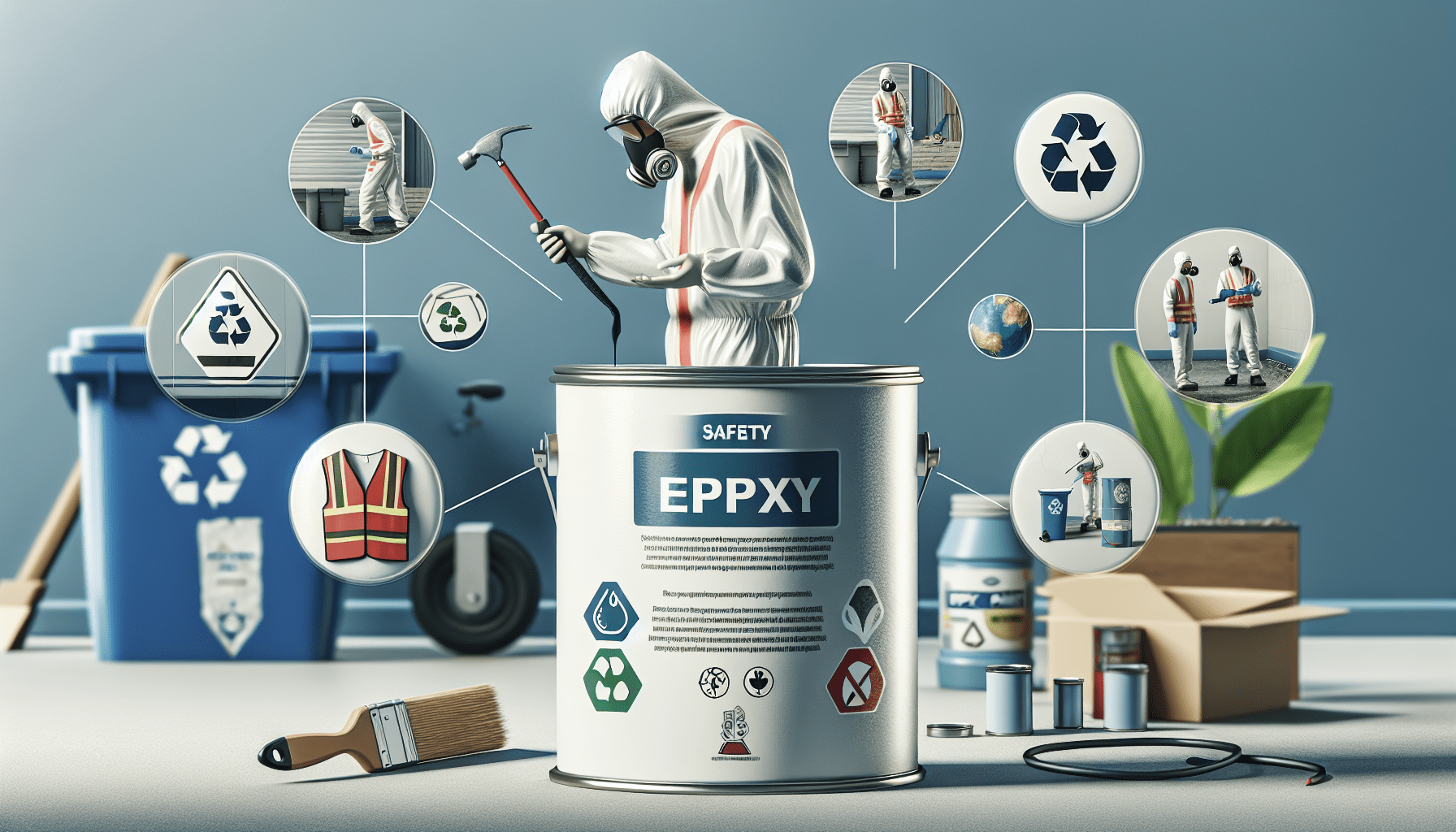Epoxy paint, a popular choice for various surfaces, has recently raised concerns regarding its safety. Understanding the potential risks associated with epoxy paint is crucial, especially for individuals who frequently come into contact with this type of paint, such as professionals in the construction and maintenance industries. In this article, we will examine the safety aspects of epoxy paint, exploring its composition, potential health hazards, and the necessary precautions to ensure a safe environment for its application. By gaining a comprehensive understanding of the safety considerations surrounding epoxy paint, you can make informed decisions and prioritize the wellbeing of yourself and those around you.

Toxicity of Epoxy Paint
Epoxy paint is a commonly used coating product known for its durability and resistance to chemicals and stains. However, it is important to be aware of the potential health hazards associated with this type of paint. Epoxy paint contains volatile organic compounds (VOCs), which can contribute to poor indoor air quality and cause various health issues. Additionally, off-gassing from epoxy paint can emit harmful fumes that can be detrimental to both human health and the environment. Allergic reactions are also a concern, as some individuals may be sensitive or allergic to the components of epoxy paint.
Health Hazards
Volatile Organic Compounds (VOCs)
Volatile Organic Compounds (VOCs) are organic chemicals that easily evaporate at room temperature, releasing harmful gases into the air. Epoxy paint often contains high levels of VOCs, such as benzene and formaldehyde, which are known to be carcinogenic and can cause health problems when inhaled or exposed to the skin. Prolonged exposure to VOCs can lead to respiratory issues, headaches, dizziness, and irritation of the eyes, nose, and throat.
Off-Gassing
Off-gassing refers to the release of volatile chemicals from a material over time. Epoxy paint can release toxic fumes even after it has dried. These fumes can persist in the indoor environment, leading to poor indoor air quality and potential health risks. It is especially important to be cautious in enclosed spaces and ensure proper ventilation to minimize the concentration of these fumes.
Allergic Reactions
Some individuals may have allergies or sensitivities to the components of epoxy paint. Contact with epoxy paint can cause skin irritations, itching, rashes, and even severe allergic reactions. It is essential to take precautions to avoid direct contact with the skin when working with epoxy paint, especially for individuals known to have allergies or sensitivities.
Safety Precautions for Using Epoxy Paint
While epoxy paint may pose health risks, following proper safety precautions can help mitigate these hazards. By taking the necessary measures and using appropriate personal protective equipment (PPE), you can minimize your exposure and ensure a safer working environment.
Work in a Well-Ventilated Area
Ensure that you are working in a well-ventilated area when using epoxy paint. Open windows and doors, use fans or ventilation systems to increase airflow, and promote the dilution of any potentially harmful fumes. Adequate ventilation is crucial in preventing the accumulation of VOCs and ensuring a healthier breathing environment.
Use Personal Protective Equipment (PPE)
Wearing appropriate personal protective equipment (PPE) is essential to safeguard your health when working with epoxy paint. This includes wearing gloves, safety goggles, and a respirator. Gloves protect your skin from direct contact with the paint, goggles protect your eyes from splashes or fumes, and a respirator helps filter out harmful airborne particles. Ensure that you select PPE specifically designed for working with chemicals and follow the manufacturer’s recommendations for their proper use.
Follow Manufacturer Instructions
Always read and follow the manufacturer’s instructions when using epoxy paint. The manufacturer’s guidelines contain important information on handling, storage, application, and disposal of the paint. Adhering to these instructions helps minimize any potential risks associated with its use and ensures maximum safety during every step of the process.
Avoid Skin Contact
To avoid skin contact and potential allergic reactions, it is crucial to wear gloves and protective clothing when using epoxy paint. If any paint comes into contact with your skin, wash the affected area immediately with soap and water. If irritation or a rash develops, seek medical attention promptly. Taking these precautions can help prevent skin-related health issues and ensure your well-being.
Dispose of Waste Properly
Proper disposal of waste generated from using epoxy paint is essential to prevent environmental contamination. Follow local regulations and guidelines when disposing of any leftover paint, empty containers, or other waste materials. Improper disposal can have harmful effects on both human health and the environment.
Considerations for Existing Health Issues
Individuals with pre-existing health conditions should exercise extra caution when working with epoxy paint. Certain health conditions can exacerbate the effects of exposure to potentially harmful chemicals.
Asthma and Respiratory Conditions
People with asthma or other respiratory conditions may be more sensitive to the fumes and volatile chemicals emitted by epoxy paint. Inhalation of these substances can trigger asthma attacks, worsen respiratory symptoms, and cause difficulty breathing. It is advisable for individuals with respiratory conditions to avoid direct contact with epoxy paint and ensure they are in a well-ventilated area when it is being applied.
Allergies and Sensitivities
If you have known allergies or sensitivities to chemicals or specific ingredients found in epoxy paint, it is crucial to take appropriate precautions. This may include avoiding contact with the paint and ensuring a safe distance from areas where it is being applied. Consulting with an allergist or healthcare professional can provide additional guidance specific to your allergy or sensitivity concerns.
Occupational Health and Safety Regulations
For individuals working in occupations that require regular exposure to epoxy paint, it is important to be aware of and comply with specific occupational health and safety regulations. Employers should provide appropriate training, protective equipment, and measures to mitigate the risks associated with working with epoxy paints. These regulations aim to ensure worker safety, minimize exposures, and prevent long-term health effects.

Long-Term Health Effects
While the immediate health hazards of epoxy paint are well-known, long-term exposure can also have serious health implications. Understanding the potential long-term health effects is vital for individuals regularly exposed to epoxy paint in both occupational and residential settings.
Carcinogenicity
Some components of epoxy paint, such as benzene and formaldehyde, are known carcinogens. Prolonged exposure to these substances, especially in high concentrations, can increase the risk of developing cancer. The International Agency for Research on Cancer (IARC) has classified these chemicals as Group 1 carcinogens, meaning they are known to cause cancer in humans. When using epoxy paint, it is crucial to minimize exposure and maintain good ventilation to reduce the risk of long-term health effects.
Reproductive and Developmental Risks
Exposure to epoxy paint has been linked to potential reproductive and developmental risks. Studies have shown that certain chemicals found in epoxy paint, such as bisphenol A (BPA), may interfere with hormone balance and have adverse effects on fertility, pregnancy, and development of the fetus. Pregnant women and couples planning to conceive should exercise caution and consider alternatives to epoxy paint to minimize any potential risks.
Cumulative Exposure
It is important to note that the health effects of epoxy paint can be cumulative. Regular and prolonged exposure to epoxy paint, especially in poorly ventilated areas, can increase the risk of developing health issues over time. Taking necessary precautions, minimizing exposure, and considering alternatives can help reduce the cumulative impact on your health.
Environmental Impact of Epoxy Paint
In addition to the potential health risks associated with epoxy paint, it is important to consider its environmental impact. Epoxy paint can have adverse effects on water and air quality, as well as contribute to waste generation.
Water Pollution
Improper disposal of epoxy paint, such as pouring it down the drain or in bodies of water, can lead to water pollution. The chemicals present in epoxy paint can contaminate water sources, posing risks to aquatic life and the overall ecosystem. It is essential to follow proper waste disposal practices and dispose of epoxy paint in accordance with local regulations to prevent water pollution.
Air Pollution
The release of volatile organic compounds (VOCs) from epoxy paint can contribute to air pollution, particularly in indoor environments. These VOCs can react with other air pollutants and form harmful ground-level ozone and smog. It is crucial to maintain proper ventilation and use less toxic alternatives to minimize the impact of epoxy paint on air quality.
Waste Generation
Epoxy paint, like any other paint, generates waste materials during application, cleanup, and disposal. Empty paint cans, brushes, and other equipment used with epoxy paint can contribute to waste generation. It is important to dispose of these materials properly, following local waste management regulations and guidelines.
Alternatives to Epoxy Paint
To mitigate the potential health hazards and environmental impact associated with epoxy paint, there are alternative coating options available that offer safer alternatives. Consider these alternatives when planning your painting projects:
Water-Based Paints
Water-based paints have lower levels of VOCs compared to traditional solvent-based paints. These paints are easier to clean up, generally emit fewer harmful fumes, and have a reduced environmental impact. Water-based paints are often preferred for indoor applications due to their lower toxicity profile.
Low-VOC Paints
Low-VOC paints are another option for reducing exposure to harmful chemicals. These paints contain significantly lower levels of VOCs than conventional paints, making them a safer choice for both human health and the environment. Low-VOC paints are widely available and come in a variety of finishes and colors.
Natural Paints
For individuals seeking truly eco-friendly options, natural paints may be of interest. Natural paints are made from renewable resources, such as plant oils and resins, and do not contain harmful chemicals or VOCs. These paints are biodegradable, have low toxicity levels, and are a more sustainable choice for those concerned about the environmental impact of paint.
Regulations and Standards
Various government agencies and industry organizations have set regulations and standards to ensure the safety and environmental sustainability of paint products, including epoxy paint.
Occupational Safety and Health Administration (OSHA) Regulations
The Occupational Safety and Health Administration (OSHA) provides workplace safety regulations that apply to the handling, storage, and use of epoxy paint. These regulations aim to protect workers from exposure to hazardous materials and ensure a safe working environment. Employers are responsible for implementing OSHA regulations and providing necessary training and safety equipment to employees.
Environmental Protection Agency (EPA) Guidelines
The Environmental Protection Agency (EPA) also provides guidelines and regulations related to the environmental impact of paint products. The EPA focuses on minimizing air and water pollution, as well as promoting the use of low-VOC and environmentally friendly paint alternatives. Following EPA guidelines helps reduce the environmental impact of epoxy paint and supports sustainable practices.
Industry Standards
Paint industry organizations and associations, such as the American Coatings Association (ACA) and the Paint Quality Institute (PQI), have established industry standards and guidelines for paint manufacturers. These standards ensure the quality, safety, and environmental friendliness of paint products. Look for paint products that adhere to these industry standards as an additional assurance of their safety and quality.
Case Studies and Research
Numerous case studies and research papers have been conducted to assess the impact of epoxy paint on health and the environment. These studies provide valuable insights into the risks and effects associated with epoxy paint.
Studies on Occupational Exposure
Occupational studies have investigated the health effects of prolonged exposure to epoxy paint in various industries. These studies have identified associations between epoxy paint exposure and respiratory symptoms, lung function decline, and other health issues. They highlight the importance of proper safety measures and adherence to regulations in occupational settings.
Impact on Residential Eco Systems
Research has also been conducted to evaluate the impact of epoxy paint on residential eco systems, including indoor air quality and potential contamination of water sources. These studies have found that poor ventilation and improper disposal practices can contribute to elevated levels of VOCs indoors and water pollution. They emphasize the need for responsible paint usage and disposal to protect both human health and the environment.
Comparative Analysis of Paint Types
Comparative analyses have been conducted to compare the health and environmental impacts of different types of paint, including epoxy paint and its alternatives. These analyses consider factors such as VOC content, environmental degradation potential, and overall sustainability. They provide valuable information for individuals looking to make informed decisions when selecting paint products.
Expert Recommendations
Health professionals and environmental experts provide valuable guidance regarding the use of epoxy paint and its potential risks.
Opinions from Health Professionals
Health professionals, including doctors and allergists, caution individuals with existing health conditions, such as respiratory issues or allergies, to be vigilant when working with epoxy paint. They recommend taking necessary precautions, such as wearing appropriate protective gear and working in well-ventilated areas, to minimize exposure and potential health risks.
Guidance from Environmental Experts
Environmental experts emphasize the importance of responsible paint usage and the use of low-VOC or natural alternatives whenever possible. They advocate for proper ventilation, waste disposal, and adherence to regulations to minimize the impact of paint products on the environment.
Conclusion
When it comes to the safety and environmental impact of epoxy paint, it is important to weigh the risks and benefits. While epoxy paint offers durability and chemical resistance, it also poses potential health hazards, particularly due to the presence of volatile organic compounds (VOCs) and off-gassing. By following safety precautions and considering alternatives, individuals can minimize their exposure and protect their health. Responsible disposal and adherence to regulations also play a crucial role in minimizing the environmental impact of epoxy paint. Ultimately, making informed decisions, based on scientific research, guidelines, and expert recommendations, is key to ensuring the safety of both individuals and the environment.



